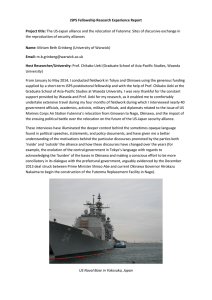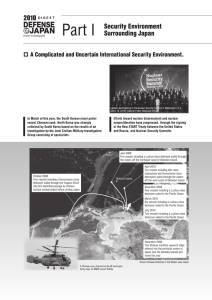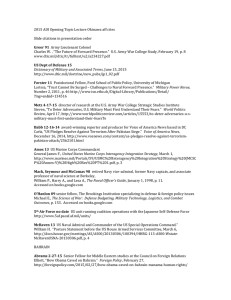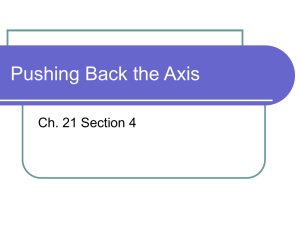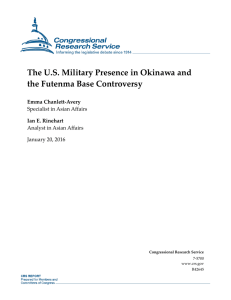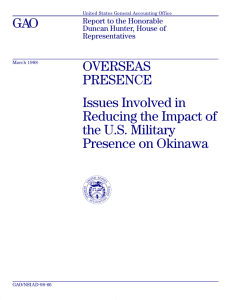Fig. III-2-2-1 Major Milestones in Security Cooperation between Japan... 1951 – The era of the former Japan–U.S.
advertisement
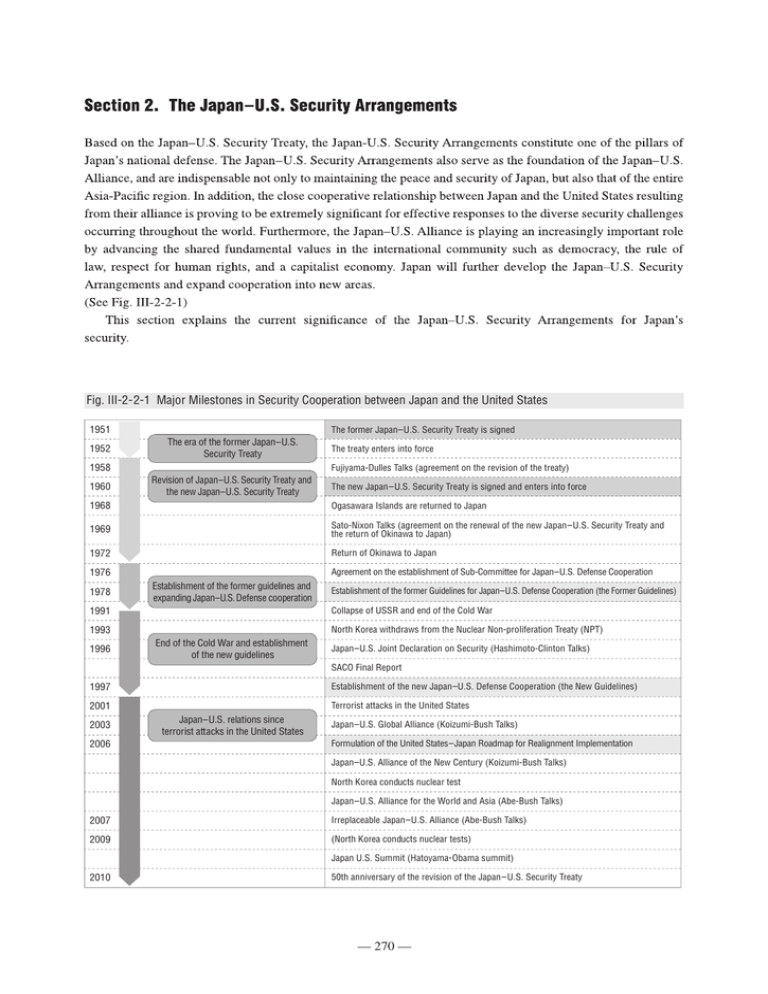
Fig. III-2-2-1 Major Milestones in Security Cooperation between Japan and the United States 1951 1952 The former Japan – U.S. Security Treaty is signed The era of the former Japan–U.S. Security Treaty 1958 1960 The treaty enters into force Fujiyama-Dulles Talks (agreement on the revision of the treaty) Revision of Japan–U.S. Security Treaty and the new Japan–U.S. Security Treaty The new Japan – U.S. Security Treaty is signed and enters into force 1968 Ogasawara Islands are returned to Japan 1969 Sato-Nixon Talks (agreement on the renewal of the new Japan – U.S. Security Treaty and the return of Okinawa to Japan) 1972 Return of Okinawa to Japan Agreement on the establishment of Sub-Committee for Japan– U.S. Defense Cooperation 1976 1978 Establishment of the former guidelines and expanding Japan–U.S. Defense cooperation Establishment of the former Guidelines for Japan–U.S. Defense Cooperation (the Former Guidelines) 1991 Collapse of USSR and end of the Cold War 1993 North Korea withdraws from the Nuclear Non-proliferation Treaty (NPT) 1996 End of the Cold War and establishment of the new guidelines Japan – U.S. Joint Declaration on Security (Hashimoto-Clinton Talks) SACO Final Report 1997 Establishment of the new Japan –U.S. Defense Cooperation (the New Guidelines) 2001 Terrorist attacks in the United States 2003 2006 Japan–U.S. relations since terrorist attacks in the United States Japan – U.S. Global Alliance (Koizumi-Bush Talks) Formulation of the United States – Japan Roadmap for Realignment Implementation Japan –U.S. Alliance of the New Century (Koizumi-Bush Talks) North Korea conducts nuclear test Japan – U.S. Alliance for the World and Asia (Abe-Bush Talks) 2007 Irreplaceable Japan – U.S. Alliance (Abe-Bush Talks) 2009 (North Korea conducts nuclear tests) Japan U.S. Summit (Hatoyama-Obama summit) 2010 50th anniversary of the revision of the Japan – U.S. Security Treaty — 270 — Part III Measures for the Defense of Japan Japan–U.S. Summit meeting (June 28, 2010) [Cabinet Public Relations Office] — 271 — — 272 — Part III Measures for the Defense of Japan Fig. III-2-2-2 Deployment Map of USFJ Atsugi U.S. Navy: F/A-18 fighters and others (Carrier-based aircraft) Shariki Misawa U.S. Army: X-Band Transportable Radar System for BMD (AN/TPY-2: so-called X-Band Radar System) U.S. Air Force: 35th Fighter Wing F-16 fighters U.S. Navy: P-3C antisubmarine Patrol aircraft and others Yokota Headquarters, U.S. Air Forces, Japan Iwakuni Shariki Misawa U.S. Marine Corps: Marine Air Group 12 F/A-18 fighters A/V-8 Harriers EA-6 electronic warfare aircraft CH-53 helicopters UC-12F and others Zama Sasebo U.S. Navy: Fleet Activities Sasebo Amphibious assault ships Minesweeping ships Rescue ships Yokota Sasebo U.S. Air Force: Headquarters, Fifth Air Force 374th Air Lift Wing C-130 transport aircraft C-12 transport aircraft UH-1 helicopters and others Atsugi Yokosuka Iwakuni Headquarters, I Corps (forward)/ U.S. Army, Japan Yokosuka Headquarters, U.S. Naval Forces, Japan U.S. Navy: Fleet Activities Yokosuka Camp Courtney and other U.S. Marine Corps facilities and areas Aircraft carriers Cruisers Destroyers Amphibious command ship U.S. Marine Corps: III Marine Expeditionary Force Torii Kadena U.S. Army: 1st Battalion, 1st Special Forces Group (Airborne)/ 10th Support Group Futenma U.S. Marine Corps: Marine Air Group 36 CH-46 helicopters CH-53 helicopters AH-1 helicopters UH-1 helicopters KC-130 tankers and others White Beach Area U.S. Navy: Port facility, POL depot — 273 — U.S. Air Force: 18th Air Wing F-15 fighters KC-135 tankers HH-60 helicopters E-3C airborne warning and control system (AWACS) aircraft U.S. Navy: P-3C antisubmarine patrol aircraft and others U.S. Army: 1-1 Air Defense Artillery Battalion Patriot missiles (PAC-3) Fig. III-2-2-3 Significance and Role of the U.S. Marines in Okinawa 4 Significance and role of the U.S. Marines in Okinawa — the strategic position of Okinawa 1. Reasons for stationing U.S. Marines in Okinawa ❍ Okinawa is closer to the regions of East Asia than mainland U.S.A., Hawaii, and Guam. Russian Federation ➔ The U.S. forces in Okinawa can respond swiftly when an emergency deployment is called for in the region ❍ Further, Okinawa has the geographical advantage of being at a reasonable distance from surrounding countries. 2. Significance and role of the U.S. Marines in Okinawa ❍ Due to their high mobility and swift response¹, the Marines stationed in Okinawa play a diverse role in securing the peace and security of the region, such as in their response to the earthquake in Java, Indonesia in May 2006, in addition to defending Japan. Mongolia Democratic People’s Republic of Korea Republic of Korea People’s Republic of China Okinawa 5,000 4,000 3,000 2,000 1,500 1,000 Taiwan Saipan サイパン Guam Philippines ➔ The stationing of U.S. Forces, beginning with the U.S. Marines in charge of first response for a variety of contingencies and capable of high mobility and rapid response, in Okinawa with its geographical characteristics, contributes greatly to the security of Japan and the peace and stability of the Asia Pacific region グアム Java Note 1: The U.S. Marines make use of all fighting elements (air, ground, and maritime) when training or carrying out operations and are capable of swiftly responding to diverse contingencies. — 274 —
